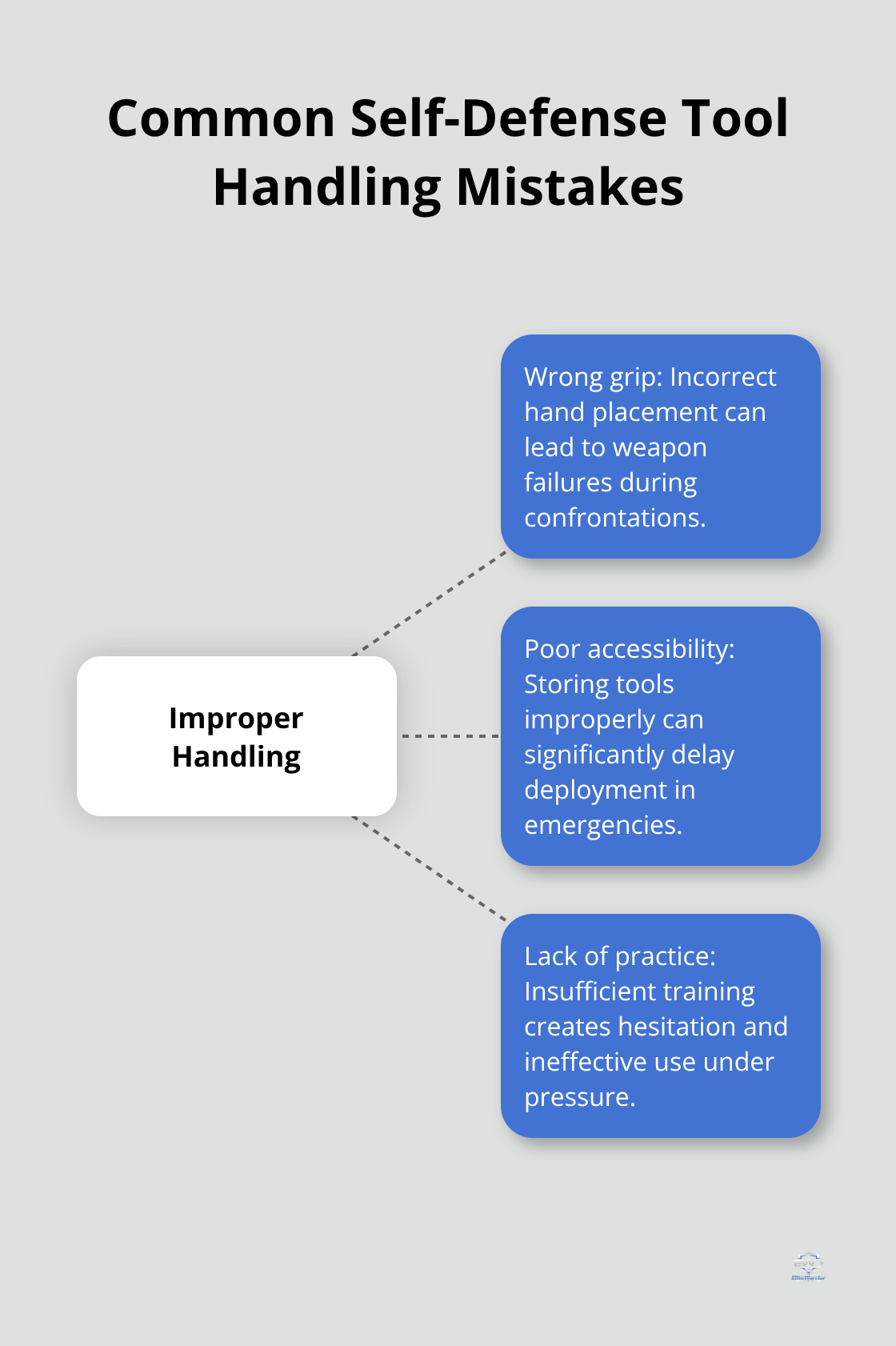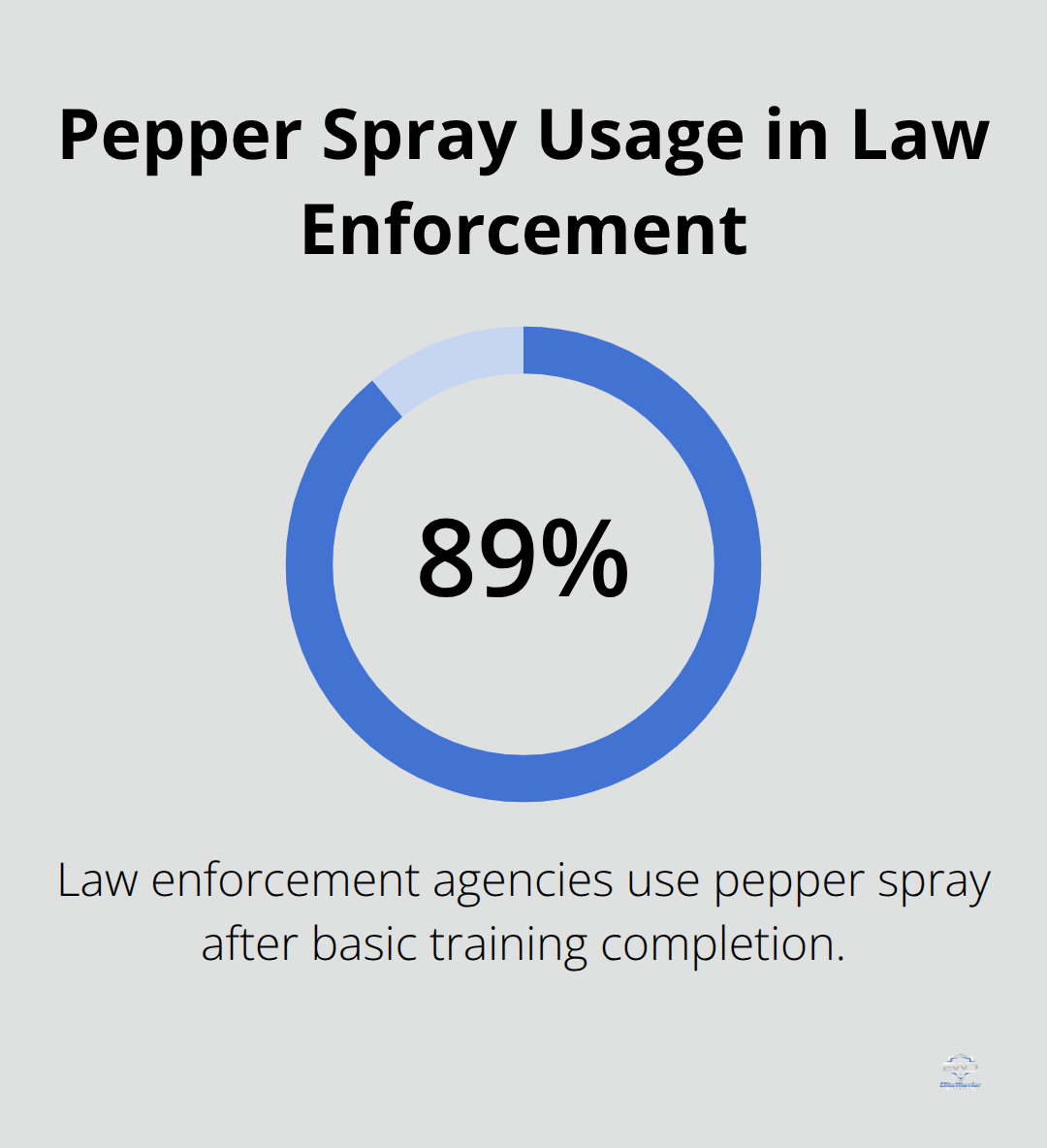Elite Warrior Defense
free shipping on orders over $25
We're having a 15% off sale on all our products. Enter your email below to be notified about future sales.

Most people carry self-defense tools but never learn how to use them properly. This dangerous gap between ownership and competency puts you at serious risk when seconds matter most.
We at Elite Warrior Defense LLC see this problem daily – pepper spray training gets skipped, stun guns stay untested, and tactical pens become expensive paperweights. The solution starts with understanding what you’re doing wrong and building the right skills through consistent practice.
Your grip determines whether your self-defense tool becomes a lifesaver or a liability. Police training data shows that improper handling techniques create significant weapon failures during confrontations. Pepper spray users consistently hold canisters too close to their body, which creates dangerous blowback scenarios.
Stun gun owners grip devices with sweaty palms or incorrect finger placement, which causes contact failures according to law enforcement training records. Tactical pen users hold these tools like regular pens instead of adopting the ice pick grip for maximum striking effectiveness. Your thumb placement on pepper spray should create a stable platform – index finger on the trigger, thumb supports the base, never wrap around the canister body.

Poor accessibility turns your self-defense tools into expensive decorations when danger strikes. Research from the National Institute of Justice reveals that improper storage can significantly impact deployment timeframes during emergencies.
Women who store pepper spray at the bottom of purses add considerable time to deployment, while men who keep tools in back pockets face similar delays. Your pepper spray belongs on a keychain or belt clip, not buried under wallet and phone. Stun guns work best in jacket pockets or specialized holsters that allow single-handed access.
Most people buy self-defense tools and never test them once. This creates a false sense of security that crumbles under pressure. Test your draw speed weekly to prevent fumbling during actual emergencies. Practice retrieving your tool regularly to build automatic muscle memory that works under stress.
Without regular practice sessions (even 10 minutes weekly), your response time increases dramatically during high-stress situations. Your hands shake, your mind goes blank, and your expensive self-defense tool becomes useless. These fundamental mistakes explain why proper training techniques make the difference between protection and vulnerability.
Pepper spray effectiveness depends on your ability to hit the target zone accurately from 6-10 feet away. Training academies show that pepper spray is used by 89% of law enforcement agencies after basic training completion. Hold your canister with a firm grip using your dominant hand, thumb on the back for support, index finger on the actuator.
Try to hit the attacker’s face triangle – eyes, nose, and mouth area. Practice the spray pattern through monthly outdoor tests; most canisters produce a cone pattern that spreads 2-3 feet wide at maximum range. Wind direction becomes critical – position yourself upwind when possible to avoid self-contamination.
Training data from police academies shows that officers who practice monthly deployment maintain significantly better accuracy rates during actual confrontations. Your monthly practice sessions build the muscle memory that stress situations demand.

Stun guns require direct skin contact for 3-5 seconds to achieve maximum effectiveness according to manufacturer specifications. Target large muscle groups like the torso, thighs, or upper arms rather than bony areas where contact may slip. Keep your device charged above 75% capacity – voltage drops dramatically with low batteries (reducing stopping power significantly).
Defensive tactics instructors emphasize that proper contact technique separates effective deployment from failed attempts. Press the electrodes firmly against the target area and maintain steady pressure throughout the discharge cycle. Your grip must remain steady even when the attacker tries to pull away.
Tactical pens require the ice pick grip with the writing tip extending from the bottom of your fist. Strike downward using your body weight, targeting soft tissue areas like the solar plexus, inner thigh, or collarbone area. The key lies in multiple quick strikes rather than single powerful blows.
Effective self-defense training focuses on five key elements that help you learn moves quickly and defend yourself faster. Your strikes should follow a pattern – strike, move, strike again (never remain stationary after initial contact).
These fundamental techniques form the foundation of effective self-defense tool usage, but mastery requires consistent practice routines that build automatic responses under pressure.
Your self-defense skills need consistency over intensity. Police training protocols show that officers who practice weapon deployment twice weekly maintain 73% better response times compared to monthly schedules. Your weekly routine should include two 15-minute sessions that focus on different tools each day.
Monday targets pepper spray deployment from various positions – standing, seated, walking. Wednesday concentrates on stun gun contact drills and tactical pen strikes against practice targets. Friday combines all tools in scenario-based sequences that simulate real confrontations.
Department of Justice data reveals that muscle memory formation requires 300-500 repetitions before movements become automatic under stress. Your practice sessions must reach this threshold through consistent weekly sessions rather than sporadic marathon attempts. Track your deployment times with a stopwatch – stun guns within 1.5 seconds from concealed carry positions.

Your environment determines skill development speed and safety outcomes. Use water-filled spray bottles to practice pepper spray deployment patterns without chemical exposure risks. Set up cardboard targets at 6, 8, and 10-foot distances to practice accuracy at various ranges. Stun gun practice requires unpowered devices or models that simulate weight and grip without electrical discharge.
Create a dedicated practice space with non-slip floors and adequate light. Your area needs 15 feet of clear space in all directions to practice movement patterns safely. Replace practice ammunition monthly and inspect equipment weekly for wear patterns that affect grip or deployment mechanisms.
Your brain needs specific repetition patterns to build automatic responses during high-stress situations. Practice your draw stroke 25 times per session, focusing on smooth consistent motion rather than speed initially.
Advanced drills should incorporate stress simulation – practice while walking, after physical exercise, or during distraction scenarios. Your progression follows a clear pattern: slow perfect repetitions build accuracy, then speed increases gradually while maintaining form. Combat instructors report that students who follow structured repetition schedules achieve competency 40% faster than those who use random practice methods.
Proper training transforms your self-defense tools from expensive accessories into life-saving equipment. The statistics speak clearly – officers with consistent training maintain 73% better response times, while untrained users often fail when confronted with real threats. Your pepper spray training and weapon proficiency directly correlate with survival outcomes during dangerous encounters.
Regular practice builds the confidence that separates victims from survivors. When you master deployment techniques through weekly sessions, your hands stop shaking and your mind stays clear under pressure. This confidence radiates outward and makes you a less attractive target to potential attackers who prey on uncertainty and fear.
Your next step involves a commitment to structured practice schedules that build automatic responses. Start with basic deployment drills twice weekly, then progress to scenario-based training that simulates real confrontations. We at Elite Warrior Defense LLC provide the tactical gear and self-defense tools that serious practitioners depend on for personal protection (including stun guns, pepper spray, and tactical pens).